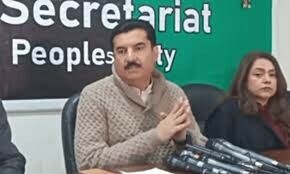PESHAWAR, Oct 25: The health department has blamed the World Health Organisation (WHO) for rise in polio cases in the NWFP, sources claimed.
A complaint in this regard was made by the executive district officer (EDO), health Peshawar, in response to an explanation sought by the provincial secretary health, regarding rise in the polio cases in the province this year, the sources said.
The UN agency reportedly provided ‘fewer’ doses to children against the P3 virus due to which the province has reported more cases this year.
The province has recorded 17 cases of the total 32 this year so far. The WHO, which is supporting the anti-polio campaign since 1994, is also procuring oral polio vaccine (OPV). However, the WHO has rejected the argument that more children had been tested positive for the P3 virus due to ‘fewer’ doses of vaccine for the same virus.
The NWFP had 16 polio cases last year.
During a presentation made to the secretary health, the EDO health Peshawar said that the district had reported 14 cases this year. All the cases, the EDO added, had been given doses of oral polio vaccine according to their ages, apart from one case whose family was a ‘silent refusal’.
The WHO had been using trivalent OPV doses against both P1 and P3 virus. It separately used monovalent OPV-1 to protect the children against P1 virus, the sources quoted the EDO health as telling the secretary health.
“Analysis of the OPV doses received by the confirmed polio cases had revealed that most of them had got less number of trivalent OPV doses as compared to monovalent OPV-1 doses,” he reportedly argued.
There is a concern that if these poliomyelitis-affected children had received more doses of trivalent OPV instead of monovalent OPV-1, they might have had enough protection against the poliovirus type-3.
Eight of the total positive cases were Afghan refugees, who had frequent travel history to Afghanistan. The P3 virus, they added, had been found in Afghanistan. The EDO, health also suggested strengthening of polio vaccination on the border with Afghanistan to put brakes on transportation of virus. He said that nine polio cases had received two doses each of the OPV3, three children had one dose each and two received zero doses.
“The problem is somewhere else, not of the type of the OPV. We have been using the same monovalent OPV-1 for other districts and the situation there was al right,” said Dr Abdul Jabbar, team leader of the WHO’s Polio Eradication Initiative (PEI) for NWFP and Fata.
Talking to Dawn, he said that the WHO had been using the monovalent OPV-1 as part of its global strategy to eradicate the P1 virus, because it was far dangerous that P3. The P1 virus, he said, had the potential to infect 10,000 children in the vicinity where it existed, whereas the P3 virus could pose threat to 2,000 children.
Dr Jabbar said that use of OPV was recommended by group of technical advisory group of the UN throughout the world.
Sources associated with the Expanded Programme on Immunisation, said that the trivalent that was given to children against P1 and P3 virus was less effective against both viruses, whereas monovalent, which is supposed to be administered for one virus was more effective. The trivalent OPV which also gives protection against P2 virus had long been eliminated.
“Now, efforts are underway at global level to manufacture biovalent OPV to provide safeguard the children against P1 and P3,” the sources informed. Trivalent OPV was cheap and easily available, while the monovalent four times effective and costly and was not available so easily, sources added.













































Dear visitor, the comments section is undergoing an overhaul and will return soon.